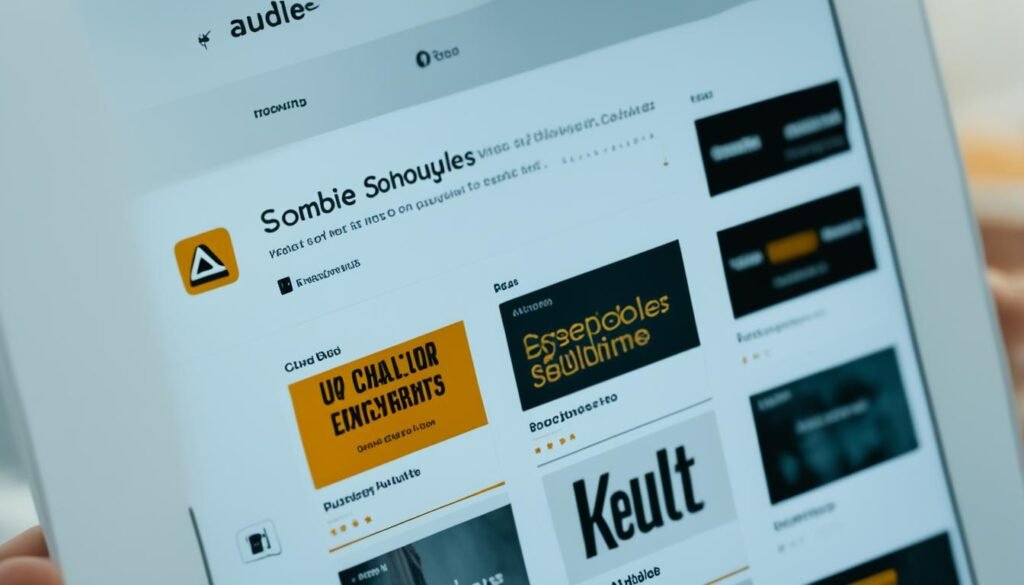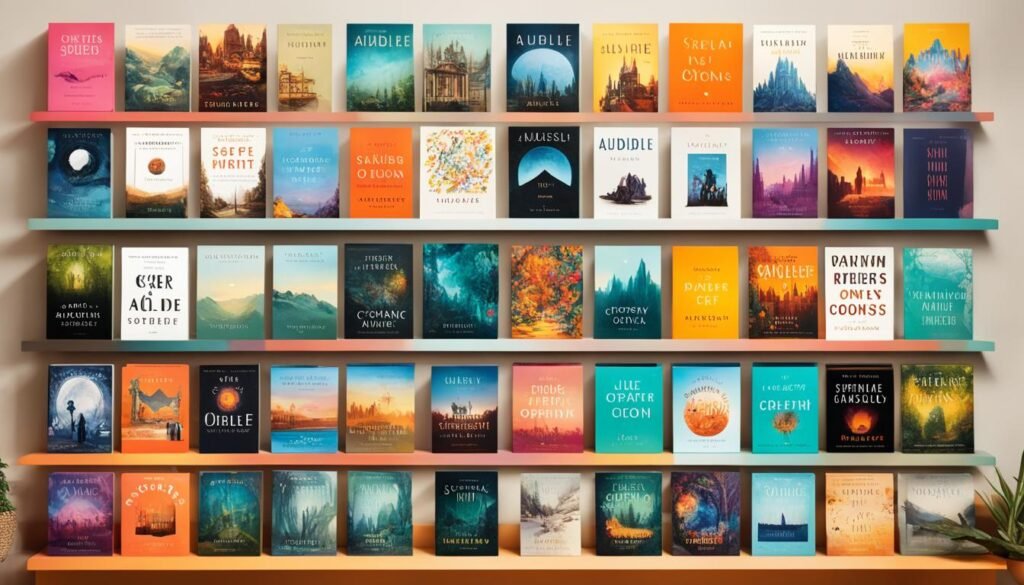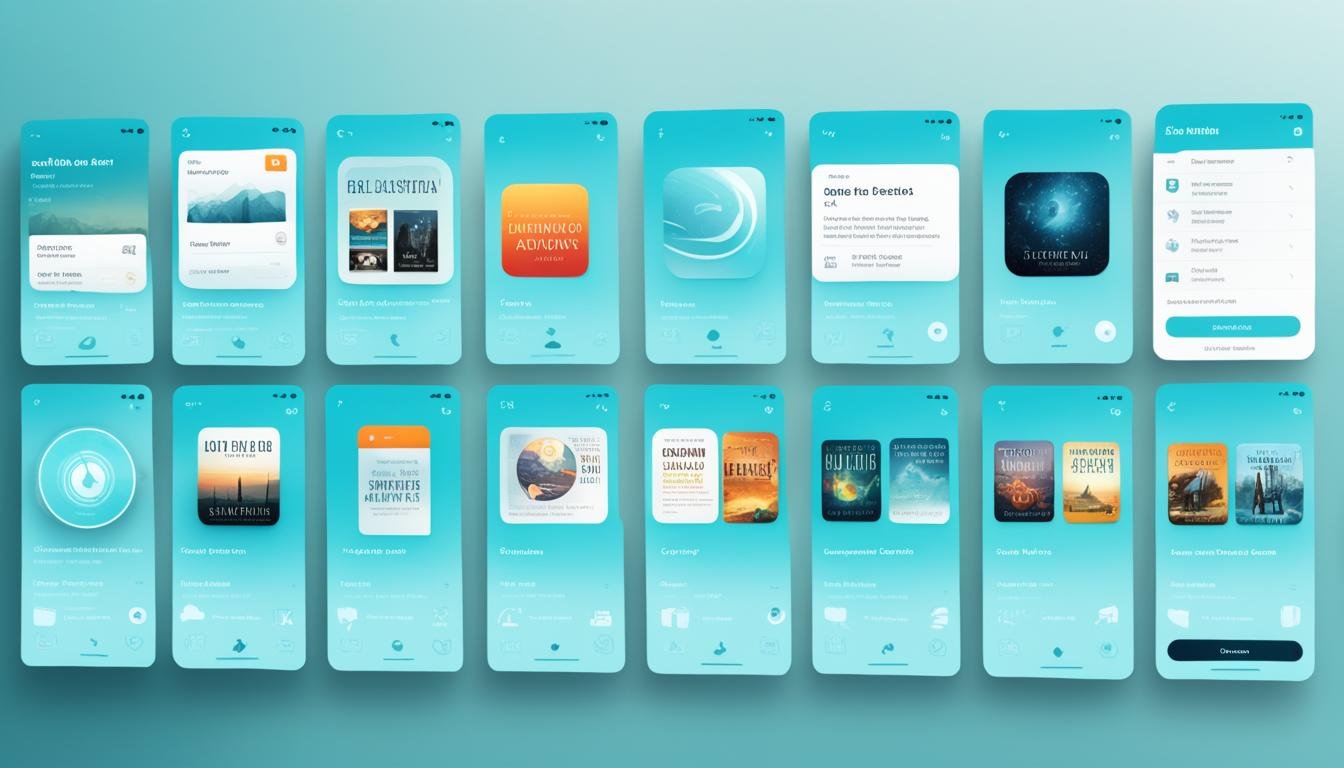The Audible app garners acclaim for its intuitive interface, simplifying navigation and the discovery and enjoyment of audiobooks. Its design seamlessly envelops users, prioritizing utility by simplifying essential tasks, including audiobook purchases and listening. Notably, the app’s expansive, easy-to-use playback controls ensure an immersive listening venture, bolstered by its distraction-free driving feature and a feature facilitating adjustment of narration speed. Given these features, Audible’s widespread appeal among audiobook enthusiasts underscores the brilliance of its user interface design.
Key Takeaways
- Audible’s user-friendly interface is praised for its intuitive design and seamless user experience.
- The app prioritizes usefulness by supporting core tasks like purchasing and listening to audiobooks.
- Audible’s accessible playback controls, driving mode, and adjustable narration speed enhance the listening journey.
- Audible’s user-friendly interface is a key factor in its popularity among audiobook enthusiasts.
- The app’s focus on usefulness over aesthetics is a strategic decision that aligns with its brand identity.
The Power of Audible’s Simplicity
Audible has distinguished itself through an interface marked by simplicity and a determined focus on core user tasks. The intuitive design facilitates effortless navigation, allowing users to navigate their audiobook libraries with ease. Entrenched in this design philosophy is the prioritization of essential functions like the purchase and sampling of audiobooks, seamlessly enabling users to engage without the encumbrance of superfluous complexity. This streamlined approach is instrumental, allowing users to direct their attention towards their primary objectives, unimpeded by redundant intricacies.
Intuitive Design for Effortless Navigation
At Audible, a design ethos that champions intuitive design paves the way for effortless navigation of its platform. This manifests regardless of the task at hand, be it the exploration for new audiobooks, management of one’s assortment, or tailoring listening preferences. The app’s clarity in structure, augmented by lucid signposts, significantly eases the accomplishment of core user tasks with negligible exertion.
Focusing on Core User Tasks
The backbone of Audible’s remarkable simplicity is its steadfast commitment to addressing core user tasks. This steadfast emphasis on crucial features, including the ability to purchase, sample, and adjust playback, means that users encounter no impediment to their listening journeys. By eliminating distractions through judicious interface design strategies, Audible ensures a fluid user experience, fostering both success and a devoted following within the audiobook community.
Audible’s User-Friendly Purchasing Experience
The core of Audible’s ease-of-use lies in its well-designed purchasing interface. Upon app launch, users confront a straightforward exhibition of their residual audiobook credits. This credit display promptly informs users of their available audiobook purchases, eradicating the necessity for recurrent balance checks.
Audiobook Sampling and Review System
Complementing this clarity is Audible’s dynamic audiobook sampling mechanism, affording users the capability to assess a narrator’s delivery prior to acquisition. This preview strengthens the user’s purchase proclivity, permitting a more discriminative selection of audiobooks that resonate with their criteria and anticipations. Moreover, Audible’s review system provides a segmented analysis, offering insight into the “Overall”, “Performance”, and “Story” elements of audiobooks. Such refinement aids users in scrutinizing the caliber and relevance of their chosen titles.
| Feature | Description |
|---|---|
| Credit Display | Clearly shows users their remaining audiobook credits, enabling informed purchasing decisions. |
| Audiobook Sampling | Allows customers to preview the narrator’s performance before making a purchase. |
| Review System | Provides detailed feedback in “Overall”, “Performance”, and “Story” categories to assist users in evaluating audiobooks. |
When amalgamated with its intuitive design, these functionalities culminate in a purchasing experience that navigates the nuances of audiobook exploration with unrivaled finesse. By equipping users with tools for insightful selection and the freedom to experiment with titles, Audible stands as the quintessential choice for discerning audiobook aficionados.

Enhancing the Listening Journey
Audible’s interface is not only intuitive but also meticulously crafted to amplify the auditory expedition. Its conspicuous, ample playback controls facilitate seamless interaction, enabling swift modulation of audiobooks, a task achievable even when engaged in diverse activities.
Large, Accessible Playback Controls
The platform’s discernible playback mechanisms simplify operations such as halting, commencing, revisiting, and advancing within audiobooks while numerous tasks demand attention. This functionality streamlines the enhancing listening journey, integrating navigational fluidity without disrupting the narrative’s cadence.
Driving Mode for Distraction-Free Listening
Adhering to vehicular audiophiles, a specialized driving mode presents itself, characterized by augmented icons and a refined control schema. Designed for distraction-free experience, it fosters undistracted vehicular concentration, harmonizing the management of audiobook progression and road serenity.
Adjustable Narration Speed for Personalization
Moreover, users are bestowed with the prerogative to modulate the narration speed, thus tailoring their acoustic consumption. This adaptive element, accommodating both the haste and languor of auditory assimilation, empowers personalized navigation, rendering the enhancing listening journey variably bespoke.
Audible’s User-Friendly Interface: Prioritizing Usefulness
In the realm of interface design, Audible emerges as an exemplar by giving precedence to utility over mere aesthetic appeal. As opined by Joshua Porter, a luminary in the field, “Usefulness is job #1.” The Audible app is distinguished by its adeptness in facilitating essential user activities, notably the acquisition and consumption of audiobooks. Despite an aesthetic elegance that might not command instant admiration, the application’s dedication to a flawless, streamlined, and user-centric interaction design significantly contributes to its allure among aficionados of audiobook literature.
The ethos of Audible’s design philosophy lies in a profound comprehension of user exigencies, coupled with an unwavering allegiance to functional simplicity. Through a concerted effort to champion efficacy, the application ensures that users encounter minimal hindrance in their quest to navigate, unearth, and savor their favorite audiobook content. This strategic alignment towards operational expediency eschews gratuitous embellishments or convolutions, thereby engendering a frictionless user experience.
Such meticulous attention to detail, with a principal emphasis on pragmatic design solutions, has empowered Audible to craft an interface that fulfills the vicissitudinous demands of its eclectic user demographic. Ranging from individuals with a passing interest in audiobooks to the most fervent enthusiasts, the platform prides itself on the delivery of an immersive auditory narrative experience. It is through this relentless dedication to optimizing utility that Audible has etched its indelible mark as a premier destination for audiobook aficionados, universally acclaimed for its unrivaled user experience.

Introducing Audible Collections
Audible Collections marks a significant advancement, empowering users to finely manage their extensive audiobook libraries with personalized and nuanced organization. It addresses a common challenge faced by dedicated Audible users, offering enhanced ways to categorize their wealth of titles. By providing a broad array of organizational tools, this new feature elevates the user’s control and experience.
Empowering Users to Organize Libraries
Through Audible Collections, individuals now have the ability to construct unique groupings of their audiobooks, aligning with their distinct tastes and organizational methods. This feature supports the sorting of audiobooks by various criteria such as genre, author, or custom tags. Such a tailor-made organizational system not only facilitates efficient library management but also allows for a more personalized audiobook journey.
Integrating with the Amazon Ecosystem
Furthermore, the introduction of Collections underlines Audible’s commitment to seamlessly integrate with the wider Amazon ecosystem, offering a unified user experience. By syncing with Amazon accounts, preferences, and features, Audible Collections bridges the user’s experience between the two platforms. This integration enhances user convenience and reaffirms Audible’s integral position within Amazon’s extensive service network.

The Importance of Audible for Audiobook Enthusiasts
Audible stands as a pivotal platform for audiobook enthusiasts, offering a remarkably user-friendly interface alongside an extensile catalogue of literary works. As the dominant leader in the audiobook realm, Audible’s acclaim endures. Recent figures indicate that 26% of the US populace acknowledged audiobook consumption within the past year, with a notable 48% within the listenership under the age of 35.
The app’s bespoke features, tailored for this burgeoning demographic, acknowledge the varied preferences within its audience. These additions, including the adjustable narration speed and a mode designed for undisturbed listening while driving, affirm Audible’s stature as the principal conduit for the audiobook enthusiast community. It ensures a unique space for aficionados of spoken-word narratives, setting a high bar for competitors.
| Key Audible Statistics | Value |
|---|---|
| US Population Listening to Audiobooks in the Last 12 Months | 26% |
| Percentage of Audiobook Listeners Under 35 Years Old | 48% |
These statistics underscore the significant and escalating influence of audiobook enthusiasts who have chosen Audible as their primary portal for literary audibles. With a steadfast commitment to meeting the desires of its diverse user base, Audible not only maintains its role as an industry vanguard but also secures its preference amongst those dedicated to aural narratives.

Researching User Pain Points
To grasp the intricacies of user dissatisfaction with Audible, the research took a multi-faceted approach. It combined in-depth analysis of feedback within the Reddit r/audible community, alongside user surveys and interviews. The insights from the Reddit r/audible subreddit, for instance, shed light on significant problems like inadequate tools for arranging audiobooks.
Reddit Community Insights
The Reddit platform, specifically its Audible subreddit, emerged as an invaluable trove of complaints and suggestions. Within this bustling digital forum, users’ varied challenges with the Audible app surfaced. The team meticulously sifted through these narratives and opinions, gleaning precious wisdom about the vexations users felt, notably regarding the management of their audiobook collections.
User Surveys and Interviews
Complementing the Reddit analysis, the research effort extended to comprehensive user surveys and focused interviews. This step was crucial, as it effectively confirmed the importance of improved library organization features. It revealed a dichotomy among users, showing that though some prioritized other aspects, a significant faction held organizational tools in high regard. These interactions were pivotal in equipping the design team with firsthand insights into user expectations.
Developing User Personas and Empathy Maps
Understanding Audible users on a profound level necessitated crafting user personas and empathy maps. In the design endeavor, these frameworks amalgamated the aspirations, obstacles, and situational contexts of assorted Audible users. The archetype, Katie, epitomized individuals with voluminous audiobook collections who grappled with the dearth of organizational tools. Conversely, Nick typified those with modest collections, esteeming simplicity and functionality over complex organizational utilities.
Exploring diverse user groups, the design phase aimed to harmonize mitigating user dissatisfactions with preserving Audible’s quintessence. This methodology guaranteed that the resultant design not only satisfied user exigencies but also resonated with Audible’s ethos and strategic intentions.
Ideating and Designing Audible Collections
The introduction of the Audible Collections feature was a strategic response to the tumult that many users faced in the realm of digital library management. In conceiving its design, a thorough examination of potential organizational frameworks was explored. Ultimately, a dynamic tagging system garnered favor, allowing for a uniquely personalized approach to collection structuring. This system not only facilitates fluid organization but also accommodates the inclusion of audiobooks into diverse contextual frameworks simultaneously.
Tagging System for Customizable Organization
The tagging system forms the backbone of Audible Collections, presenting users with the opportunity to curate a bespoke system of categories and tags for efficient audiobook organization. Tailored to individual inclinations, this method of customizable organization empowers users to cluster their audiobooks based on selected genres, moods, or any relevant criterion. Such flexibility is unquestionably a cornerstone of its innovation, enabling users to navigate their auditory libraries in a manner that resonates most deeply with their unique preferences.
Supporting Book-First and Collections-First Use Cases
A pivotal aspect of the Audible Collections design is its compatibility with both book-first and collections-first utilization paradigms. This duality allows for a modular approach, where users may commence with a selection of audiobooks and subsequently assign them to pertinent collections, or opt to initiate by structuring collections and subsequently populate them with audiobooks fitting the respective theme. Such versatile functionality is pivotal in ensuring the seamlessness of Audible Collections with the varied organizational and consumption proclivities of its expansive user base.
Prototyping and User Testing
During the design phase, the integration of prototyping and user testing proved pivotal in enhancing the Audible Collections feature. The team crafted interactive prototypes, which became the substrate for both in-person and remote usability assessments. Through these meticulously orchestrated evaluations, the team managed to confirm the validity of their initial suppositions. It was established that users grappled with a dearth of organizational functionalities. Moreover, their receptivity towards a feature such as Audible Collections was palpable.
Validating Hypotheses and Iterating
The insights gleaned from users served as the bedrock for refinement, catalyzing a series of iterative design modifications. This dynamic process was meticulously executed to specifically tackle identified pain points while augmenting the overall experience. The essence of the iterative methodology was in ensuring that the final design effectively met the expectations of the users. Not only did it cater to their needs, but it seamlessly integrated with Audible’s strategic vision and brand image.
Audible’s Brand Identity and Visual Competitive Analysis
In parallel with user research and design endeavors, our team embarked on a comprehensive exploration of Audible’s brand identity, contextualized within the vibrant visual panorama of the audiobook and podcast app domains. Audible’s brand identity, underpinned by a melange of qualities such as entertainment, ease, accessibility, elitism, and thrill, functioned as a lighthouse for our design philosophy. This approach was meticulously crafted to harmonize with Audible’s foundational values and strategic positioning in the industry.
An in-depth competitive scrutiny unearthed a dichotomy; a cohort of competitors embraced vivid hues and avant-garde visuals, while others, including Audible, opted for a less conspicuous pathway. In the case of the Audible redesign, fidelity to the initial branding was prioritized. This choice was strategic; it aimed to fortify the platform’s distinct and esteemed brand image, leveraging its recognized standing among audiophiles and beyond.
Critical analysis of Audible’s brand identity coupled with an exhaustive visual competitive analysis galvanized our design team. The result was a user interface that not only tackled prevalent user challenges but also dovetailed perfectly with the overarching brand narrative. This all-encompassing strategy preserved the quintessence of the Audible experience, appealing to both the current user base and prospective individuals.
Redesigning Audible’s Interface
The redesign of Audible’s interface was an intricate process. It aimed to refine the existing layout, rectify inconsistencies, and elevate the user’s journey. This endeavor was centered on the integration of consistent design elements. It encompassed elements like standardizing button shapes and harmonizing the application’s color scheme. The overarching goal was the amalgamation of an interface that not only captivated but also invited engagement.
Consistent Design Elements
The focal point of the redesign initiative was the seamless integration of consistent design elements across Audible’s interface. By fortifying these core visual elements, a definitive and momentous brand image commenced. This was pivotal for consolidating Audible’s position as the go-to platform for devoted audiobook aficionados.
Improved Readability and Separation
Enhancement efforts also extended to the readability and separation of content. This strategy streamlined navigation and facilitated swift data retrieval for users, thereby refining the user experience. Moreover, these alterations were neither abrupt nor stark; they were meticulously woven into the interface’s fabric. This gentle approach ensured the preservation of Audible’s essence, highly regarded by its patrons.
The amalgam of these subtle design flourishes significantly enriched the Audible engagement, harmonizing the quintessence of its brand identity with an elevated user experience.
Conclusion: Aligning Design with Brand Values
The Audible interface redesign illustrates a paradigm where design synergizes with brand fundamentals. It delves into Audible’s brand essence, positioning it as an engaging and exclusive haven for audiophiles. Thus, the design epitomizes a strategic fusion of aesthetics and function, addressing user challenges while underscoring the brand’s unique allure.
This meticulous process, encapsulating user-centricity and brand ethos, culminated in a cohesive user Audible experience. It mirrors the platform’s distinct identity and values. Emphasizing design’s pivotal role in driving a brand forward, this integration ensures Audible’s trajectory of innovation is buoyed by design’s support. It’s a partnership that enriches user experiences and fosters brand loyalty.
The alignment of design with brand values transcends the superficial; it is a critical strategy in propelling a product’s or service’s distinctiveness. Audible’s recent redesign vividly upholds this belief, showcasing how deliberate design strengthens the user journey while celebrating the brand’s heritage. As the conclusion rightly notes, employing such a comprehensive strategy unveils a digital platform’s true potential and embeds the brand in its audience’s collective consciousness.
